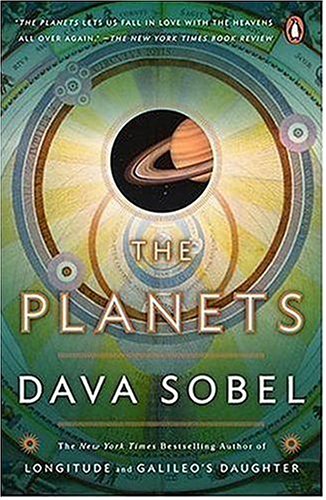Just Another Planet Book?
January 2006 :
 When our local town librarian called my attention to a new addition to our library, I wondered if it were just another planet book by a non planetary scientist. But I checked it out and began to read. After a few pages I was drawn in enough to finish the book in a few sittings and was glad I had taken the time to do so. Dava Sobel, the author of Longitude and Galileo’s Daughter, begins her story by recounting her own childhood fascination with the planets. Then she devotes a chapter to each of the planets, though Uranus and Neptune share a chapter. Sun and Moon also get a chapter each, so the book might have been entitled The Solar System.
When our local town librarian called my attention to a new addition to our library, I wondered if it were just another planet book by a non planetary scientist. But I checked it out and began to read. After a few pages I was drawn in enough to finish the book in a few sittings and was glad I had taken the time to do so. Dava Sobel, the author of Longitude and Galileo’s Daughter, begins her story by recounting her own childhood fascination with the planets. Then she devotes a chapter to each of the planets, though Uranus and Neptune share a chapter. Sun and Moon also get a chapter each, so the book might have been entitled The Solar System.
She finds an interesting and unexpected vantage point for each celestial orb. The subject of creation leads into the birth of the Sun. From the background of Greek and Roman mythology she introduces Mercury, the messenger to the gods. The Venus chapter is called “Beauty” and includes the mildly interesting coincidence that each evening or morning apparition of Venus (goddess of love) lasts for nine months, equal to the human gestation period. A brief history of geography is the backdrop for the chapter devoted to Earth. Lunacy is paired with her musings on the Moon.
The Mars chapter is related from the perspective of the Martian meteorite AH84001. That chunck of rock, found on an Antarctican glacier, tells its instructive and violent life story. Author Sobel reminds her readers that before the split between astrology and astronomy many notable scientists (Johannes Kepler, for one) practiced on both sides of the heavenly “fence”. Then she casts a fanciful horoscope for the Galileo probe to learn how its astronomical fate matches its astrological prediction. A colorful picture of Jupiter is painted in the process. The story of Gustav Holst’s famous planetary composition ushers in the description of Saturn and the most recent Cassini and Huygens missions.
One of the best chapters for me was the story of Uranus and Neptune, told in the form of an imaginary letter from Caroline Herschel to Maria Mitchell. Miss Herschel congratulates Miss Mitchell on her comet discovery, then tells the story of the Uranian and Neptunian discoveries from her unique perspective. Well done. She points out the curious fact that the orbital period of Uranus matches the life span of its discoverer - 83.7 years.
Finally, the whole UFO phenomenon, the dreams of the aristocratic Bostonian, Lowell, and the perseverance of the Kansas farm boy are woven together to tell of Pluto. It includes a succinct discussion of the planet or TNO status of our Uncle Clyde’s discovery.
I am grateful to our librarian for pointing this book out to me. It provided a couple of hours of good reading. But I probably will not invest the $24.95 to keep a copy on my shelves.



